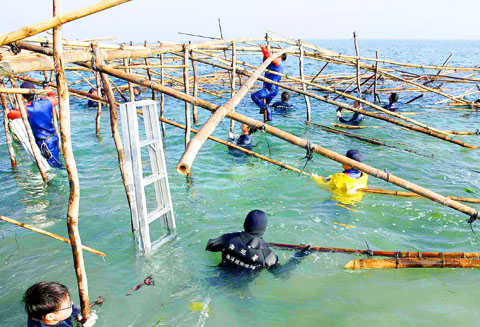Chinese fishermen have been accused of poaching in Taiwan’s first marine national park, where authorities say their destructive methods are endangering the area’s ecology.
“Chinese fishing boats have been posing the gravest threat to the fragile ecological system here,” said Shaw I-pung (蕭一鵬) of the Marine National Park headquarters, speaking of the tiny coral atoll called Dongsha Island.
“They have been using illegal methods like poisons, dynamite and electricity to exploit marine resources in the region,” he said.

PHOTO: AFP
The scourge of boats scouring the seabed for food destined for Hong Kong restaurants is combining with global warming as a major cause of coral reef bleaching, he said.
The Dongsha Islands, comprising Dongsha Island and two coral reefs which are submerged at high tide, straddles a strategically important sea route at the north of the South China Sea linking the Pacific and Indian oceans.
The island is a coral atoll with a land area of 2.4km². It measures 0.9km from east to west, and 2.7km from north to south.
Shaw said the unquenched appetite for Hong Kong’s famed Cantonese seafood is to blame.
“Most of the marine catches here, like fishes and lobsters, are quickly sent to Hong Kong, which touts itself as the world’s biggest living fish market,” he said.
Chinese fishermen, plus some Vietnamese, use cyanide to stun fish and catch them live for higher commercial prices, he said.
“Cabrilla can be sold for US$30 per kilo in Hong Kong and some other fish even sell for up to US$100 per kilo,” Shaw said.
Dongsha is 267km away from Hong Kong and 380km from Kaohsiung City.
“Smaller fish and corals were destroyed by the poisons, largely cyanide, which is easily available in China,” Shaw said.
However, “the destructive way of fishing has been endangering the coral reefs near Dongsha,” which Shaw described as an “ocean rain forest” and a biodiversity hot spot.
Academics found there are 264 species of coral, 556 species of fish and 140 species of bird — many of them migratory — in that area.
Taiwan’s coast guard says it has stopped 3,820 ships infiltrating the prohibited Dongsha waters since they were deployed in 2000.
Taiwan withdrew its Marines from Dongsha in 2000 in what the government said was a move to help alleviate tensions in the South China Sea.
Currently there are around 200 coast guard personnel are stationed on Dongsha and armed with a fleet of six patrol boats — three 10-tonne vessels and three other eight-tonne boats. There are no civilian inhabitants.
But the fleet is apparently not strong enough to serve as a “deterrent” to the Chinese and Vietnamese invaders.
“They often come back after we leave,” a coast guard officer said on condition of anonymity.
The government is now building the first permanent pier on the island to house the three incoming 20-tonne boats.
“Bigger ships would help us battle invaders as they increase our cruising capability,” said Liu Kuo-lieh (劉國列), the Dongsha coast guard commander.
As part of its ocean conservation efforts, the government inaugurated the Dongsha Marine National Park in January last year. The park administration is centered on the monitoring and conservation of the local ecology.

An essay competition jointly organized by a local writing society and a publisher affiliated with the Chinese Communist Party (CCP) might have contravened the Act Governing Relations Between the People of the Taiwan Area and the Mainland Area (臺灣地區與大陸地區人民關係條例), the Mainland Affairs Council (MAC) said on Thursday. “In this case, the partner organization is clearly an agency under the CCP’s Fujian Provincial Committee,” MAC Deputy Minister and spokesperson Liang Wen-chieh (梁文傑) said at a news briefing in Taipei. “It also involves bringing Taiwanese students to China with all-expenses-paid arrangements to attend award ceremonies and camps,” Liang said. Those two “characteristics” are typically sufficient

A magnitude 5.9 earthquake that struck about 33km off the coast of Hualien City was the "main shock" in a series of quakes in the area, with aftershocks expected over the next three days, the Central Weather Administration (CWA) said yesterday. Prior to the magnitude 5.9 quake shaking most of Taiwan at 6:53pm yesterday, six other earthquakes stronger than a magnitude of 4, starting with a magnitude 5.5 quake at 6:09pm, occurred in the area. CWA Seismological Center Director Wu Chien-fu (吳健富) confirmed that the quakes were all part of the same series and that the magnitude 5.5 temblor was

The brilliant blue waters, thick foliage and bucolic atmosphere on this seemingly idyllic archipelago deep in the Pacific Ocean belie the key role it now plays in a titanic geopolitical struggle. Palau is again on the front line as China, and the US and its allies prepare their forces in an intensifying contest for control over the Asia-Pacific region. The democratic nation of just 17,000 people hosts US-controlled airstrips and soon-to-be-completed radar installations that the US military describes as “critical” to monitoring vast swathes of water and airspace. It is also a key piece of the second island chain, a string of

The Central Weather Administration has issued a heat alert for southeastern Taiwan, warning of temperatures as high as 36°C today, while alerting some coastal areas of strong winds later in the day. Kaohsiung’s Neimen District (內門) and Pingtung County’s Neipu Township (內埔) are under an orange heat alert, which warns of temperatures as high as 36°C for three consecutive days, the CWA said, citing southwest winds. The heat would also extend to Tainan’s Nansi (楠西) and Yujing (玉井) districts, as well as Pingtung’s Gaoshu (高樹), Yanpu (鹽埔) and Majia (瑪家) townships, it said, forecasting highs of up to 36°C in those areas